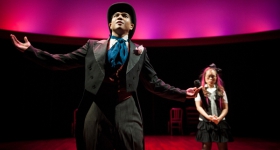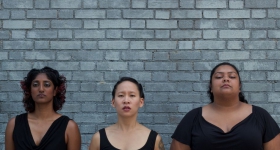Before walking into Vicki Virk's Bhangra Dance class, my experiences with the folk dance originating from the Punjab region of India had been in sweaty clubs with over-enthusiastic Desi boys wriggling their shoulders a little too close to my personal space. While Jay-Z's recent discovery of Panjabi MC brought the infectious dhol (a large barrel-shaped drum) sounds to the masses, bhangra has been ruling mainstream Desi parties for the last 15 years. But shaking my badunkadunk (yes, that’s a bhangra bassline in Missy Elliot's “Get Ur Freak On”) in a bhangra class at the gym? I wasn't sure what to expect.
Virk—a small-framed, sweet-faced woman—wasn't your typical bubbly aerobics instructor. To start out, she led the class—of mostly white women at a fancy gym—through a series of serene stretches. But as soon as the dhol beats began emanating from the speakers—everyone's energy levels began shooting through the roof. As we bounced through the routines—shaking our shoulders and swaying our hips—the room came together, laughing at the difficult steps and catching our breath at the end of the songs. An hour later, my thighs were burning and my heart was racing. I had underestimated the power of the bhangra.
“It is a great workout,” Virk, 31, co-founder of Dhol Rhythms, says. “It is something that originated among farmers in the field. It is a dance of labor—it requires energy and stamina. You use your entire body from head to toe—it's a full cardio workout. People get bored in aerobics classes. This is such a fun workout, because they are learning new moves, listening to new music, learning about a new culture.”
Virk, who came to the U.S. from the Indian state of Punjab at the age of 12, says that dance has always been a huge part of her life. “You know how it is though, as Indian kids we aren’t taught that your hobbies or passions are something that you can make a living at,” Virk says. So instead, Virk went to law school after college and worked for three years as an investment banker at Goldman Sachs. One day, she was driving through San Francisco with her friends, blasting bhangra on the system. “I just turned down the music and said, 'Wouldn't it be great to teach people?' " A year later, Virk teaches classes all over the Bay Area and leads a multiethnic bhangra dance troupe made of 15 women.
Virk's not the only one who is cashing in on the energy of bhangra. Sarina Jain, dubbed “the Indian Jane Fonda” started promoting her Masala Bhangra workout videos back in 2001 and now she offers four DVDs so you can bhangra the calories off in your living room. New classes are popping up in L.A. and even Detroit.
One of the best parts of Virk's classes is that you can learn the dance moves at the gym and then come to her “Non-Stop Bhangra” parties in San Francisco and work it out on the dance floor. I found Korean American Carrie Kroon, 25, in full bhangra regalia—a short kurta top and wide legged drawstring pants, arms covered in bangles and a sparkly bindi on her forehead—getting down at one of Virk's parties at the Blue Cube in San Francisco.
“I started out just wanting to try a good workout but I love it because of the energy,” Kroon says, who became a member of Virk's dance troupe after a few months of classes.
“People are embracing bhangra. It's becoming really mainstream,” Kroon says. “I went to a club recently and found that I couldn't really dance anymore to regular music.”
— Writer Neelanjana Banerjee; Photographer David Huang









Comments